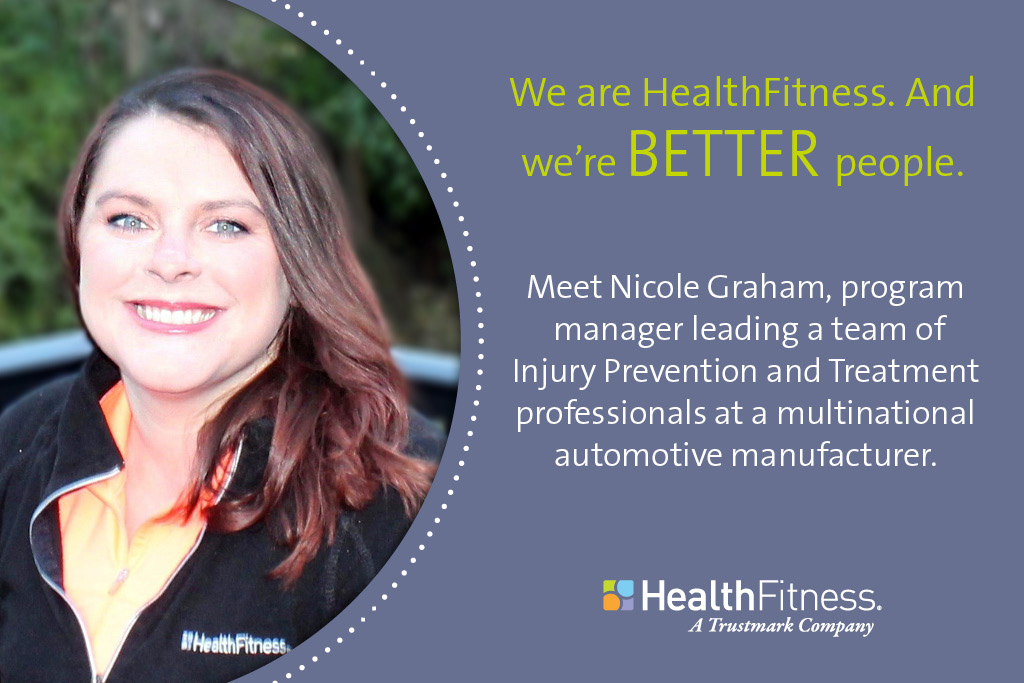HealthFitness
Published by HealthFitness on January 7th, 2019
With an education in athletic training, sports medicine, coaching and psychology, Nicole Graham’s favorite part of her job makes perfect sense. “I really enjoy the coaching part of my position,” says Graham. “Mentoring my team and supporting their work to keep our client’s employees safe and productive makes me really happy, and I find it really motivating as well,” Graham says.
 As program manager for our injury prevention and treatment program at a multinational automotive manufacturer, Graham and team focus on a proactive and preventive approach to injury reduction. “My team’s goal is to help employees remain at work and return to work after both work- and non-work-related injuries,” Graham explains. “We use education and biomechanics training to help employees move smarter, safer and more efficiently,” says Graham.
As program manager for our injury prevention and treatment program at a multinational automotive manufacturer, Graham and team focus on a proactive and preventive approach to injury reduction. “My team’s goal is to help employees remain at work and return to work after both work- and non-work-related injuries,” Graham explains. “We use education and biomechanics training to help employees move smarter, safer and more efficiently,” says Graham.
Team effort
Graham’s team covers four locations, working mainly with manufacturing populations that are predominately male. The team of 16 injury prevention professionals, with backgrounds in exercise science, physiology, biomechanics and athletic training, deliver injury prevention and treatment services including:
Success in safety
Graham and team focus on early intervention programming to help keep eachemployee safe. “We use a proactive, preventive approach, and our goal is to be the touchpoint with employees before an injury occurs and before they head to medical,” says Graham.
Results over a 12 month period include a 94 percent success outcome (percent of incidents that did not become an OSHA recordable) of the 11,000 employees who participated. Across the locations, the cost avoidance totaled more than $8 million (determined by the number of participants, times the average cost of an OSHA recordable from an ergonomic injury).
“Our team has the support of front-line leadership and team leaders,” Graham says. “But building those relationships with employees, developing that trust and offering encouragement really makes the difference in our success,” Graham says. “Seeing my team bring those attributes every day is what a good day looks like for me, for sure,” Graham says.
Learn more
How can our people help your people be better? Connect with us to learn more.
 As program manager for our injury prevention and treatment program at a multinational automotive manufacturer, Graham and team focus on a proactive and preventive approach to injury reduction. “My team’s goal is to help employees remain at work and return to work after both work- and non-work-related injuries,” Graham explains. “We use education and biomechanics training to help employees move smarter, safer and more efficiently,” says Graham.
As program manager for our injury prevention and treatment program at a multinational automotive manufacturer, Graham and team focus on a proactive and preventive approach to injury reduction. “My team’s goal is to help employees remain at work and return to work after both work- and non-work-related injuries,” Graham explains. “We use education and biomechanics training to help employees move smarter, safer and more efficiently,” says Graham.Team effort
Graham’s team covers four locations, working mainly with manufacturing populations that are predominately male. The team of 16 injury prevention professionals, with backgrounds in exercise science, physiology, biomechanics and athletic training, deliver injury prevention and treatment services including:
- Work conditioning - prepares employees for optimal and safe performance using exercise, strengthening and work simulation
- Line-side coaching - promotes movement efficiencies and use of tools
- Pre-shift warm-up - prepares employees for the demands of the job
- Early intervention programming - assess early signs and symptoms prior to need for medical diagnosis and treatment
Success in safety
Graham and team focus on early intervention programming to help keep each
Results over a 12 month period include a 94 percent success outcome (percent of incidents that did not become an OSHA recordable) of the 11,000 employees who participated. Across the locations, the cost avoidance totaled more than $8 million (determined by the number of participants, times the average cost of an OSHA recordable from an ergonomic injury).
“Our team has the support of front-line leadership and team leaders,” Graham says. “But building those relationships with employees, developing that trust and offering encouragement really makes the difference in our success,” Graham says. “Seeing my team bring those attributes every day is what a good day looks like for me, for sure,” Graham says.
Learn more
How can our people help your people be better? Connect with us to learn more.
